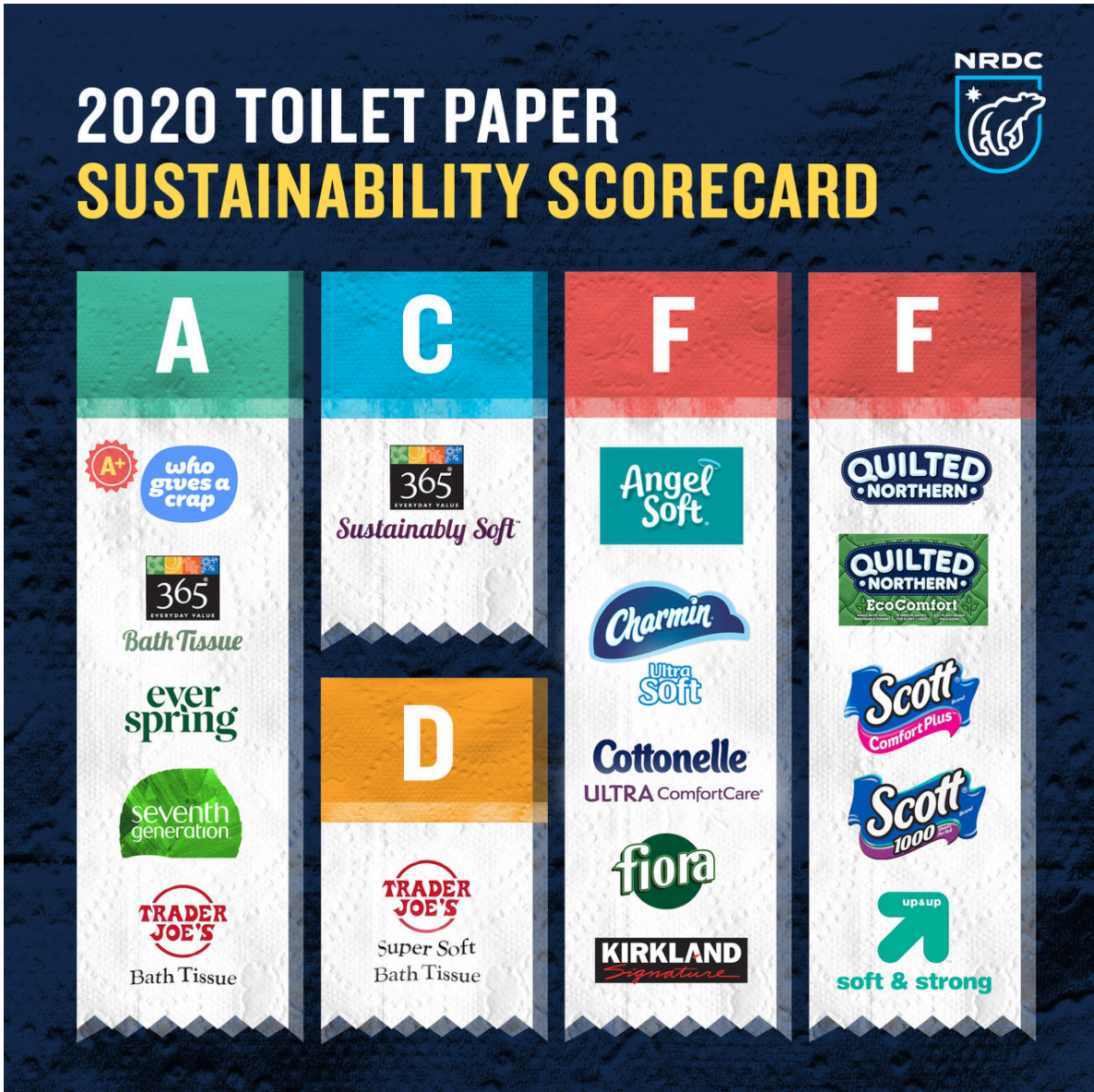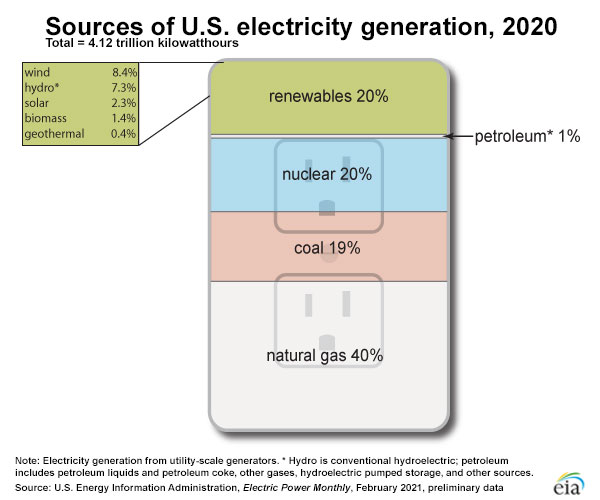What would happen if we put nature at the heart of every choice we make? Is it possible that we can Restore Our Home Planet? Take the 10-question quiz below to see just how green your love for Mother Earth is.
1. Do you use recycled toilet paper?
Are you wiping your bottom with an ancient tree? The singing bears might be wining advertising awards, but they are failing the grade of sustainability. Many of us are purchasing toilet paper from companies that are denuding our forests. Trees and plants are one of the most important sources of carbon removal from the atmosphere. They also clean the air we breathe, moderate temperatures, provide shade and keep the soil moist and rich in nutrients.
Check out the NRDC’s toilet paper report card below.

2. Do you take the stairs?
Every button we push is connected to a power source. Imagine how expensive our electric bill would be if we installed an elevator in our home, instead of stairs. If we take the stairs in government buildings, there will be more civic funds for education, planting trees and other endeavors that create a better tomorrow.
In many states, fossil fuels are still the primary power source for electricity. Every time we push a button, a coal power plant, or fracking company, or a nuclear power plant is firing up. Using less contributes to a more sustainable world, and it also leaves more money in our budget for things we might enjoy even more. Taking the stairs also promotes physical health.

3. Are you still working from home?
In many cities across the developed world, 2020 offered the bluest skies we’ve seen in our lifetime. Carbon emissions were down 7% globally in 2020. The reduction contributed from nobody driving or flying anywhere was profound. During the height of the lockdowns, road transportation was down by half. In December of 2020, aviation travel was still reduced by 40%. If everyone returns to their normal commute, emissions will increase with the population growth. If we embrace working from home and videoconferencing for meetings, we can continue the transportation emissions reductions.
4. Are you purchasing organic food?
Protecting our pollinators is key to survival. Many of the pesticides used by conventional farming are harmful to bees and butterflies. Organic food is rich in antioxidants, vitamins and is free of residue that can be unhealthful for humans as well. Just as importantly, however, it contributes to the preservation of the mini beasts that are essential for planetary plant health.
5. Have you done an air test on your home, school and office to see just how energy efficient your dwelling is?
When you turn on the cooling in your home are you actually cooling the outside air? Do you have so many leaks that your unit has to stay on constantly in order to keep the inside cool or hot? A well-insulated home, combined with smart choices like curtains in the summer, can save you thousands of dollars every year. Typically, the investment will be minimal, and often it is tax deductible. There are still energy efficiency tax credits available In the United States and many other countries around the world. The money saved at school can be used for the arts, updated technology hardware and software and school gardens. Savings at the office are essential to profitability, which helps you to keep your job and receive raises. Of course, a reduction in fossil fuels and energy usage is a great way to show our love for the planet that nourishes and sustains us.
6. Do you bike or walk for local errands?
A lot of people do large shopping trips by car. However, a backpack and a walk to the store can mean that you don’t have to get into a car at all (particularly if you’re working from home). For most people giving up their car adds up to thousands saved annually, when you factor in the car payment, the insurance, vehicle maintenance and gasoline. Foot and pedal power are clean energy that promote heart health. With obesity rates at 1/3 in the U.S., the value of a trend toward walking and biking cannot be overstated (source: CDC).
If your city has not yet put in bike lanes, then becoming more active in your community plans will contribute to making your streets friendly to pedestrians and micro mobility.
7. Are you conserving water?
Do you live in a desert with green grass in the front lawn? Does your yard reflect the natural habitat? Fresh water is something we all have an interest in preserving. Other ways to conserve water include grey water systems for plant watering. Smart landscaping techniques will keep the soil moist. In rural areas, you might even consider reed beds and other vegetation that offer natural filtration. Mark Nelson, one of the original Biospherians, has a book called The Wastewater Gardener.
8. Are you composting food waste?
Up to 40% of food that is purchased is never eaten. Even if you are pretty efficient about buying only what you eat, there are still avocado pits, orange peels, egg shells and coffee grounds. Composting saves energy, protects the climate and returns valuable nutrients to the soil. Food waste can be up to 1/3 of a city’s garbage (source: Seattle.gov). In a landfill, it produces methane, which is harmful to the atmosphere. Many cities already allow composting in the yard bin. Again, if yours doesn’t, then it’s time to become more involved.
9. Do you live by the 7 Rs of sustainability?
Rethink. Refuse. Reduce. Repurpose. Reuse. Recycle. Rot.
0. Is your community powering with clean energy, or are you being deceived by marketing ads?
Know the source of your power! Santa Monica, California, powers 100% with clean energy. Poundbury, England, installed their own anaerobic digester, which provides heating for their township and the surrounding community. Meanwhile, 60% of the U.S. power grid is powered by fossil fuels. Some states are greener than others, with California taking the lead at 44% renewable energy. Florida is one of the biggest polluters, with 83% fossil fuels (76% natural gas and 7% coal). Sometimes the utilities will brag that they’ve doubled their solar. In the case of Florida, that would be going from 1.3% to 2.6% solar. Remember that the cleanest energy source is the energy you don’t use, by taking the stairs, riding a bike, insulating your home and working from home.
11. Do your local schools and community have gardens?
You can lower the temperature and increase the humidity in a neighborhood that is blighted by concrete by planting trees and gardens. Ron Finley transformed his home in a food desert into his own private Eden. School gardens offer fun ways for kids to learn about science and math, and to experience where their food comes from. It also promotes healthy eating. At the Edible Schoolyard, a garden project begun in 1995 by Alice Waters in Berkeley, California, one of the students told me her favorite snack was kale pesto!
12. Has your community dispensed with plastic bags and straws?
In Poundbury, England, the children at Damers First School (with the help of their eco-teacher extraordinaire Edd Moore) wrote to the food distributors asking them to deliver their food without plastic coverings. They then went on to encourage a local shop to offer plastic-free produce. You can dispense your own milk at the shop, in addition to the fresh produce and bulk goods that are available. Individuals took it upon themselves to create Boomerang Bags – reusable cloth bags that anyone can use free of charge. (Many grocers sell canvas bags for a nominal fee.)
13. Are you still using single-use products and containers?
Cloth diapers can be swapped out for disposable plastic ones. (They feel better on the baby’s bottom, too.) Diaper services make this easy and mess-free. Opt for drinking your coffee at home, or at cafes that serve in cups rather than disposable paper and plastic. Purchase stackable food storage containers which create more space in your refrigerator (particularly useful now that so many of us are eating at home more). EARTHDAY.ORG has a plastic calculator so that you can add up just how wasteful your habits truly are (or are not).
Can you think of things I’ve forgotten? Do you wish to share something you’ve shifted in your own life? Please use the hashtag #EarthGratitude, so that I can like and reshare your wisdom.
The Earth Gratitude Project
Earth Gratitude on YouTube
Earth Gratitude on Instagram
Earth Gratitude on Twitter
Earth Gratitude on Facebook
Please share this quiz with your community. Together, we can be the change we wish to see.
Final Thoughts on: Financial Independence. Sustainability Independence.
What is the true value of money, if not to offer us greater freedom to live the life of our dreams? What is the true value of life? Plants, animals, trees, rivers, oceans and mountains offer us our sustenance, but also joy and adventure. Everything is intertwined in a divine and sacred braid. There is not wealth without freedom. There is no life without biodiversity. They haven’t done a great job of preserving wealth and life for us. We must believe, achieve and create for ourselves. If we do this on a planetary scale, our climate anxiety can be exchanged for the hope of restoring our home planet for our children and grandchildren. This is worth taking a look at our habits and making our love for our planetary home more apparent. The blessings will be many and unexpected, and will include more money in your budget for the things you truly cherish and love doing, rather than the multitude of quite unsustainable traps that we’ve fallen collectively into.
If you’d like to learn how to put your money where your heart is, and make sure that you’re not profiting from polluters, then join me for our 3-day Investor Educational Retreat. Get additional information at https://www.NataliePace.com/.


